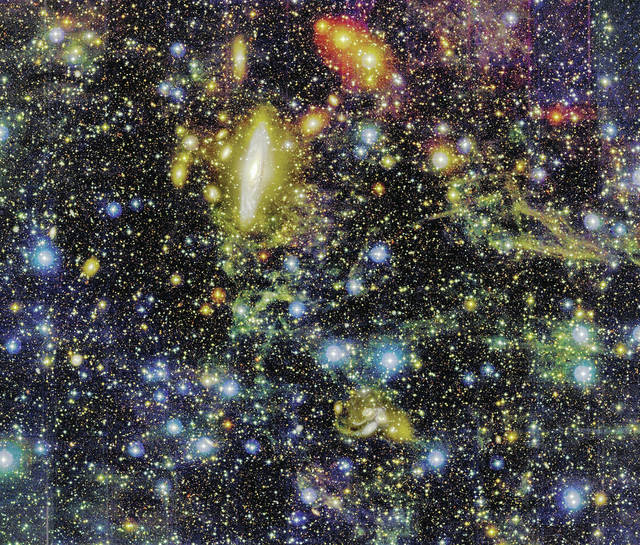A new optical image from Canada-France-Hawaii Telescope (CFHT) casts light on the formation process of Stephan’s Quintet, a famous group of five colliding galaxies. The image shows several features common to galaxy clusters, including some very dim and extended filaments of interstellar gas or galactic cirrus. The image also reveals unexpected structures including dome undetected thus far. In particular, astronomers discovered a very extended red halo composed of old stars, and centered on an elliptical galaxy, NGC 7317, which had been ignored in previous studies on the dynamics of the global collision.
A new optical image from Canada-France-Hawaii Telescope (CFHT) casts light on the formation process of Stephan’s Quintet, a famous group of five colliding galaxies. The image shows several features common to galaxy clusters, including some very dim and extended filaments of interstellar gas or galactic cirrus. The image also reveals unexpected structures including dome undetected thus far. In particular, astronomers discovered a very extended red halo composed of old stars, and centered on an elliptical galaxy, NGC 7317, which had been ignored in previous studies on the dynamics of the global collision.
The detection of red stars implies that this galaxy has been interacting for a very long time with the other members of the group of galaxies. Interactions such as the one seen in these observations are called galactic cannibalism. Galactic cannibalism occurs when the gravitational forces from a larger galaxy or group of galaxies slowly tear apart a smaller galaxy. Characteristic features of galactic cannibalism are streams or halos of stars orbiting the larger galaxy, like the halo of red stars seen around NGC 7317. Ultimately, astronomers hypothesize that the galactic cannibalism around NGC 7317 will lead to the formation of a giant elliptical galaxy.
The Canada-France-Hawaii Telescope captured the wide field image with its 380 megapixel camera called Megacam. Stephan’s Quintet was named after French astronomer Édouard Stephan who first observed the compact group of five spiral and elliptical galaxies in 1878. The Hubble Space Telescope immortalized this region after observations of the group became one of the telescope’s most iconic images. Stephan’s Quintet is a perfect target for studies on the collective evolution of galaxies. Such collections of galaxies are subjected to a range of gravitational interactions ranging from slow collisions creating gravitational stellar streams, high-speed galactic collision, gas ramming, starbursts and the creation of intergalactic stellar systems.
This discovery comes as astronomers have a renewed interest in deep imaging of nearby galaxies, a task that the Canada-France-Hawaii Telescope is particularly well suited for.
“With Megacam, CFHT is at the forefront of an observing technique called low-surface brightness imaging,” said Daniel Devost, CFHT’s director of science. “This allows astronomers using CFHT to make discoveries like the galactic cannibalism discovery within Stephan’s Quintet.”
Our own Milky Way galaxy may be cannibalizing smaller satellite galaxies orbiting us. Astronomers observe streams of hydrogen gas and stars arcing from the Large and Small Magellanic Clouds. These dwarf galaxies are located 160,000 to 200,000 light years away from the Milky Way, but are significantly smaller than the Milky Way. The immense gravity of the Milky Way slowly pulls the smaller galaxies apart, causing the transfer of materials between our galaxy and the clouds.
While the Magellanic Clouds are not visible from Hawaii, both objects are visible from the Southern Hemisphere. It is believed they served as important navigation markers for Polynesians.




